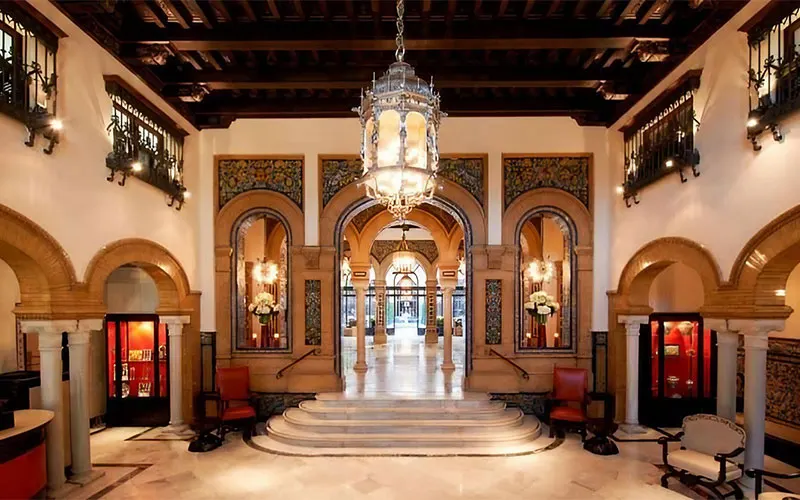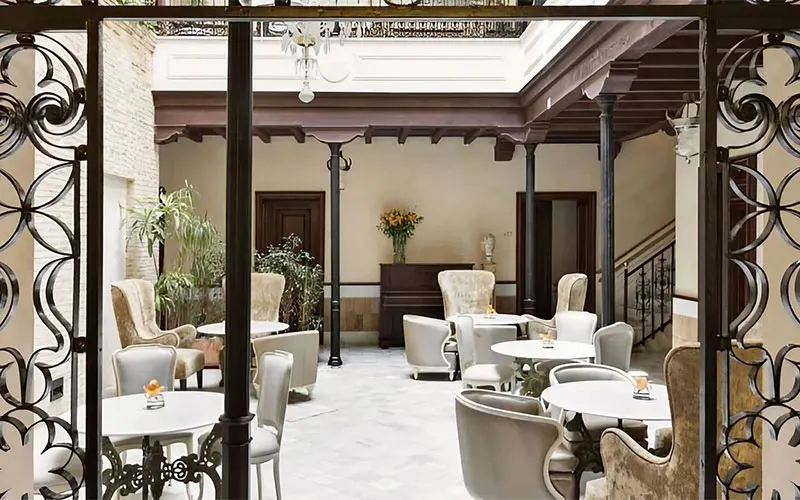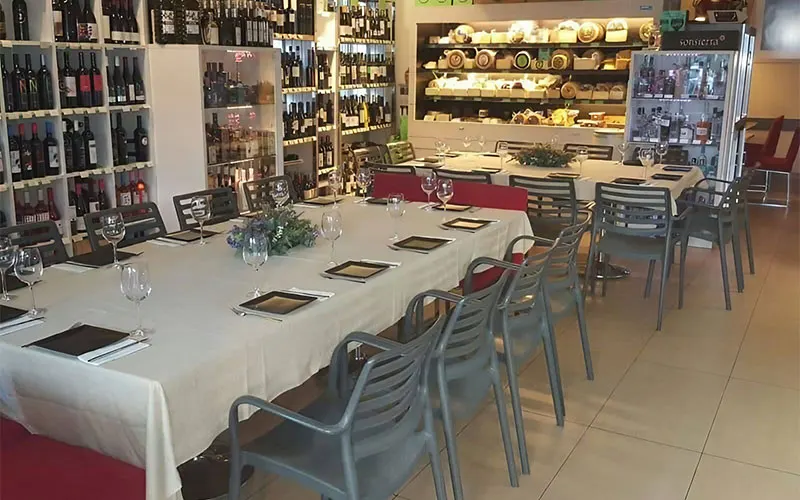Seville Guide
Our Guide To Seville
“Quien no ha visto Sevilla, no ha visto maravilla.” – “Who hasn´t seen Seville, hasn´t seen a marvel.” Popular Refrain
The beating heart of Andalucia, Seville intoxicates its guests with a palpable sense of both romantic and tragic drama. Leaving no-one indifferent, the Sevillanos possess a beguiling temperament and celebrate the myriad of local customs, traditions and ferias with boundless energy that can leave visitors feeling quite exhausted. Homes are small, but the streets, plazas and parks are welcomingly large, and it is here where the Sevillanos live out their theatrical lives on an open stage. It’s true what they say: once you have one true Sevillian friend, you have a hundred.
‘The Cradle of the Baroque’ became the wealthiest city on the planet after the discovery of America, boasting over 50 churches and chapels replete with ornate treasures of sculpture and art. Home to the world’s largest Gothic cathedral and the oldest continuously-inhabited European Royal Palace, the “City of the Senses” possesses the lifeblood of the Andalucian character – bold, bright, romantic and mysterious.
Accommodation
Our Pick of the Best Luxury & Boutique Hotels in Seville
Hotel Alfonso XIII
This magnificent neo-Mudejar hotel was built to house the family of King Alfonso XIII of Spain for the Ibero-American Exposicion (World Fair) of 1929; it’s handily located between the city centre and Maria Luisa Park, site of the Expo. Recently refurbished, the 151-room five-star landmark property boasts a swish, elegant cocktail bar with live music, a traditional patio cafe, a gourmet tapas bar and a Mediterranean eaterie by the pool, as well as a more formal restaurant. Decorated with traditional Triana ceramic tiles and classy contemporary fabrics, it retains an air of timeless elegance. Cool off in the pool, and for the ultimate in regal splendour, the Royal Suite has 200m2 of priceless antiques, crystal chandeliers and portraits of Spanish royalty.
Address: Calle San Fernando, 2, 41004 Seville, Spain; 954 91 70 00

Hotel Palacio de Villapanes
The epitome of modern luxury, this 18th-century marquess’ palace is located on a quiet street close to the lively Arenal area. High ceilings, soothing hues of dark grey, and the latest Loewe TVs and iMacs in 50 guest rooms (iPhone docks, home-made chocolate brownies and cava in suites) make it a five-star chic choice.
The restaurant, serving creative Andalucian cuisine, is located downstairs in the atmospheric vaulted wine cellar, as is the small spa with relaxation room, steam bath and pebble walk; massages can be arranged. On the rooftop the bar with its small plunge pool offers views of Seville, with live flamenco in summer, or have a drink in one of the delightful palm-filled patios.
Address: Calle Santiago, 31, 41003 Seville, Spain; 954 50 20 63

Las Casas del Rey Baeza
Located few steps away from the hustle and bustle, close to the Metropol Parasol architectural monument, this four-star hotel is built around traditional stone-floored patios dating from the 13th century with a rustic feel – esparto grass blinds, deep blue windows and terracotta pots full of colourful blooms.
In the 41 rooms you’ll find Indonesian wood floors and neutral tones, with wood beams salvaged from a medieval hospital. Azahar restaurant offers seasonal dishes using Andalucian ingredients with a modern twist. The rooftop pool and spa offer the chance to relax while gazing at the nearby Cathedral and Giralda.
Address: Plaza Jesús de la Redención, 2, 41003 Seville, Spain; 954 56 14 96
Eurostars Sevilla Boutique
With a definite urban feel, the tone for this four-star hotel, on a quiet street in Barrio Santa Cruz a few steps from the cathedral, is set by the fluffy white avant-garde lights as you enter, and the central patio’s glam decor: black tables and gold sofas with purple velvet cushions.
Unusually for Seville, the hotel has a full-sized pool in its terrace garden, while the rooftop bar, offering intimate corners in its many different areas on various levels, is one of the city’s most popular summer hang-outs as well as being used for launches and events. The 40 guest rooms are themed in a glamorous palette of white, silver and purple.
Address: Calle Abades, 41-43, 41004 Seville, Spain; 954 97 90 09
Hotel Casa 1800
Visit websitehotel casa 1800 courtyard seville
This charming, boutique hotel in the very heart of Barrio Santa Cruz has a historic and classic feel, with 33 rooms over three floors. The 19th-century mansion has opulent furnishings and chandeliers which give a sense of grandeur, while still being intimate – think baroque gold headboards, brocade chairs, combined with the stone pillars and wood-beamed ceilings typical of Sevillano houses. The duplex suite has an outdoor Jacuzzi, and there’s also a rooftop pool for all the guests, where you can help yourself to complimentary afternoon tea in the sunshine as you admire the Giralda.
Address: Calle Rodrigo Caro, 6, 41004 Seville, Spain; 954 56 18 00

Restaurants
Our Pick of a Few of the Best Places to Eat in Seville
Petit Comite
One of the new generation of tapas venues in Seville, this elegant bar with tiled floor and Parisian vibe – wooden café-style furniture, framed prints on the wall, plus mosaic-tiled bull’s head for the Sevillano touch – is located in the Arenal district, close to the river. Helpful service and innovative, sophisticated takes on local favourites have quickly won it a loyal following.
Address: Calle Dos de Mayo, 30, 41001 Seville, Spain; 954 22 95 95

ConTenedor
Seville’s slow food pioneer, this homely neighbourhood restaurant concentrates on seasonal, local, organic ingredients such as game from Seville province and fish from Cadiz. Located deep in the Macarena district, on Calle San Luis close to pretty Plaza San Marcos, it offers tapas at lunchtime but only raciones (large plates) in the evening; house specials include crunchy rice with duck and mushrooms. The eye-catching abstract artworks which line the walls of the boho space are by one of the owners, and this cultural theme extends to the live acoustic music on Tuesdays. Don’t miss the home-made ice-creams. Reservations essential.
Address: Calle San Luis, 50, 41003 Seville, Spain; 954 91 63 33
Vineria San Telmo
A firm favourite with locals and visitors alike, this lively locale serves tapas with a modern touch, such as salmon, aubergine and pumpkin ratatouille quiche, or grilled tuna with onion compote and crispy rocket. Those with a sweet tooth shouldn’t miss the superb dessert trolley, with delectable treats made by the owner’s wife – lemon meringue pie or rich flourless chocolate tart. You can choose to sit inside, where philosophical quotes dot the ceiling, or outside on the terrace. The wine list is impressive, with a good range of Sherries and local Andalucian wines, each with its own description – an unusual, and helpful, touch.
Address: Paseo de Catalina de Ribera, 4, 41004 Seville, Spain; 954 41 06 00
Albarama
This classy, modern eaterie is a winner in terms of location: right on Plaza San Francisco, one of Seville’s oldest and most historic squares. Restaurant tables are at the back in a light-filled, spacious dining area, with suspended plant pots, under a pretty glass roof. You might be tempted by cod with cabbage and bacon or risotto of mushrooms and duck, beautifully presented. Their wine list includes the excellent and well-priced Rueda K-NAIA (a pun on the word canalla, which means riff-raff), as well as Rioja Reserva Finca Valpiedra.
Address: Plaza de S. Francisco, 5, 41004 Seville, Spain; 954 22 97 84
Abades Triana
Situated right on the river, offering one of Seville’s best views – two 13th-century Moorish towers, the Torre del Oro, and the Giralda, both floodlit at night and impossibly romantic – this upmarket restaurant with stunning contemporary design offers a refined ambience. Take the opportunity to dress up for the occasion, and enjoy cuttlefish eggs with garlic and olive oil foam, or turbot with courgette spaghetti. Pastries take a novel angle on traditional favourites, such as nougat pestiños (honey pastries) with candied almonds and apricot ice cream. The outdoor terrace is an ideal spot to enjoy a fine dinner on a balmy summer’s night on a foodie tour.
Address: Calle Betis, 69, 41010 Seville, Spain; 954 28 64 59

Tapas Bars
Our Favourite Tapas Bars
Bodeguita Antonio Romero
Sit at the long bar in this family-run Seville stalwart in the Arenal district, and savour classic tapas such as the house speciality, montadito de pringa (slow-cooked pork and black pudding in a hot roll), or a seriously meaty stew – carrillada (pork cheek) or rabo de toro (bull’s tail). For the less carnivorous, traditional tapas such as gambas al ajillo (garlic prawns) and pimientos del padron (little green peppers) are your best bet. The interior has classic Triana ceramic tiles and to complete your all-Andalucian experience, try some Sherry from the excellent wine list.
Address: Calle Antonia Díaz, 5, 41001 Seville, Spain; 954 22 14 55

Flores Gourmet
Situated between Triana bridge and the central shopping area, with a large outside terrace, this shop/restaurant bills itself as a wine specialist, with 30 wines and Sherries by the glass. But it is also heaven for jamon iberico fans, with several types of this cured Iberian ham, as well as cheeses, all of which you can either eat there, buy to take away, or if you over-estimate your appetite in ordering, both! In addition to these locally-produced delicacies, quirky dishes include chipiron (baby squid) cooked in its ink with rice and raisins, ensaladilla with purple potatoes, and pork carpaccio with truffle and liver sauce.
Address: Calle San Pablo, 24, 41001 Seville, Spain; 954 21 61 60

La Azotea
This group of four superb bars, owned by a Californian and her Sevillano husband, pioneered gastro-tapas in Seville. Located in the Alameda, centre and Santa Cruz districts, all are small spaces, ensuring excellent, attentive service and consistently outstanding food. A daily market special is matched with wine by the glass; must-tries include coquinas (baby clams) with artichokes, solomillo de buey (ox loin) and, to finish off, coulant de chocolate. Prices are higher than many other tapas bars, but then so are standards, the food and wine are wonderful. Of the four, only Azotea Santa Cruz has outside space, as well as serving delicious, healthy breakfasts.
Address: Calle Jesús del Gran Poder, 31, 41002 Seville, Spain; 955 11 67 48
Eslava
Another Seville classic, this hugely popular tapas bar is tucked away in the untouristy San Lorenzo district, home to one of the city’s most important Semana Santa (Holy Week) processions. The long, narrow interior features an always-busy bar, which is the best place to soak up the lively atmosphere, although you can also get a table at the back. Dishes to try include pork ribs with honey sauce, croquettes and deep-fried sea anenomes, plus award-winners: cheese emulsion on tomato bread with anchovies and olives, and slow-cooked egg on boletus and truffle cake. The extensive wine list includes offerings from Andalucia as well as neighbouring Extremadura.
Address: Calle Eslava, 3, 41002 Seville, Spain; 954 90 65 68
Sal Gorda
A cosy, informal place improbably located on a pedestrianised street full of shoe shops, with a small outside seating area and two floors of dining tables inside, this new tapas mecca has some of the friendliest waiting staff in the city. The menu is highly seasonal, with fruits and vegetables (mushrooms in autumn, figs in late summer) creating original, colourful combinations for daily specials: cherry salmorejo, seabass ceviche with lemon and passion fruit. Year-round winners include tender tartar de atun (tuna tartare) and endive, beetroot, orange, walnut and cheese salad. The hip young owners are keen supporters of Seville’s craft beer scene.
Address: 41004, Calle Alcaicería de la Loza, 17, 41004 Seville; 955 38 59 72
Things To Do
The TOMA Edit of Seville Attractions
Alcazar – Royal Palace
A magnificent and exquisitely decorated palace which dates from many different eras, this is the oldest royal palace still in use in Europe. The main, Mudejar (Moorish-Christian) part was built under the order of Catholic King Pedro the Cruel in the 14th century, by Moorish craftsmen – look out for the Spanish and Arabic inscriptions on the façade; other parts are original Moorish, Gothic and Renaissance. The palace was chosen as a filming location for the hugely successful TV series Game of Thrones – the exotic tiles and dreamy plasterwork make a perfect Water Gardens of Dorne. Lose yourself in the huge gardens, criss-crossed by endless paths lined with tiled seats, tinkling fountains and long, cool pools.

Cathedral/Giralda
The biggest Gothic cathedral in world, and the third-largest, this was built over a Moorish mosque. Its soaring nave, 42 metres high, houses Christopher Columbus’ tomb, as well as the keys of city handed over by the Moors (Muslims from North Africa) to Christian King Fernando III when he reconquered the city in 1248. One of the highlights is climbing the Giralda, the basilica’s iconic belltower which was formerly the minaret of the mosque. Views from the old city’s highest point at 105 metres are spectacular, especially over Barrio Santa Cruz, the old Jewish quarter. Don’t miss the Puerta de Perdon on your way out, a beautifully carved arch which remains from Moorish times.
Real Maestranza
Seville has one of Spain’s oldest and most important bullrings, which seats 11,500. Full of pomp and ceremony, this most quintessentially Spanish tradition sees lithe, brave adrenalin-fuelled men wearing gold-embellished suits dodge 500kg of solid toro bravo muscle while brandishing a pink cape. An elliptical shape, the Seville plaza de toros has seats divided into sol (sun) and sombra (shade). You can visit the bullring and see the small church and emergency hospital, where medical staff patch up bull’s horn gashes and save lives short-term, before the wounded bullfighters are sent off to be stitched up by surgeon.

Museo de Bellas Artes
Housed in a former convent, with pretty, leafy patios and tiled ponds, this is considered to be one of Spain’s finest collections of religious art, with works by Golden Age painters Zurbaran, Murillo and Valdes Leal. Look out for Zurbaran’s Santa Dorothea with her rich fabrics in fabulous colours and Bilbao Martinez’s Las Cigarreras – the cigarette girls who inspired the opera Carmen, which is set in Seville (although most of the 20th-century paintings are less impressive). Temporary exhibitions usually feature Spanish artists, and there are often paintings on loan from other museums which are put on special display.
Casa de Pilatos
This privately-owned palace is a hidden gem in that it is less celebrated (or busy) than the Alcazar, but is still spellbindingly beautiful and definitely worth visiting. Built on land confiscated during the Spanish Inquisition, it has Roman busts, wooden artesonado ceilings decorated with gold, and some of the most stunning azulejos (ceramic tiles) you’ll see in the whole city. Upstairs are the private rooms of the Dukes of Medinaceli, Spanish aristocrats whose ancestral seat this is, with paintings by Goya. One of the gardens has an incredible collection of classical and Renaissance statues brought over from Italy by a 16th-century ancestor.
Day Trips
Jerez
If you’ve ever had a glass of sherry, this small, lively city is where it originated (Sherry-Xerex-Jerez). Wines produced from grapes grown in this area, and aged and blended within the “Sherry Triangle”, inspire cultish passion in their followers. The city itself is conmpact and fun, with its atmospheric tabancos (traditional sherry bars) and plenty of spontaneous live flamenco, including an excellent annual festival in February/March.
A visit to a bodega (winery) is a must – the musty, evocative smells of the barrels, the vaulted arches of the “cathedrals” where the wine is aged, and of course the tasting. The city is also famous for its beautiful purebred horses.
White Villages
The Pueblos Blancos in the province of Cadiz make an excellent day trip from Seville, following the spectacular winding roads around mountains and through cork forests, from one picturesque hilltop town to the next. This is the real Andalucia, where traditional crafts are still practised, such weaving baskets and making cheese. Roads are steep, windy and cobbled, with potted geraniums providing a vivid touch of colour against the white walls. For centuries these Moorish-built towns were on the frontier between Islamic and Catholic Spain. Ronda has an especially stunning position with its majestic 98-metre-high bridge spanning the gorge of the Tajo river.
Osuna
This small town, near the border between Seville and Malaga provinces, boasts some extraordinary baroque architecture, streets lined with extravagant sandstone facades adorned with twisted pillars and carved vines. Above the town is the La Colegiata de Santa Maria de la Asuncion, a large church containing the Dukes of Osuna’s art collection, and next to it you can see the University building, which looks like something out of a Disney film with its four blue spires. Osuna gained worldwide fame when a key scene from Games of Thrones was filmed in its bullring, featuring some mighty fire-breathing dragons.
Cordoba
Once the seat of the Moorish Caliphate, and for a time the largest and most important city in Western Europe, Cordoba is home to one of Spain’s most important monuments: the Mezquita. This mosque-cathedral dates from the 8th century, with the Christian part being added in the 13th century after the Reconquest. You might recognise its endless striped horseshoe-shaped arches, with pillars taken from Roman and Visigothic buildings, and designed to resemble a forest. The Alcazar (Royal Palace) has stunning gardens, and another monument you shouldn’t miss is the Roman bridge, also featured in Game of Thrones, although digitally enhanced.
Granada
Who can come to Andalucia without visiting the Alhambra? Perched on a hilltop overlooking the city, backed by the snow-kissed Sierra Nevada mountains, the complex of ochre-coloured towers and buildings is a sight you’ll never forget. Inside the Nazari Palaces, sumptuous salons and pretty patios provide a glimpse into the life of the Moorish rulers. Wonder at the sublime three-dimensional intricacy of the stucco and arabesque plasterwork and the vaulted ceilings inlaid with thousands of tiny pieces of painted wood. Opposite is Granada’s hillside quarter, the Albayzin, with its carmenes, mansions whose secret gardens are full of fruit trees (granada means pomegranate in Spanish).
Flamenco
Where to See Authentic Flamenco in Seville
Museo del Baile Flamenco
The brainchild of dancer Cristina Hoyos, this museum explains about the origins of the typically Andalucian music form, which is composed of toque (guitar), baile (dance), and cante (song). Displays show typical clothes worn by dancers in the early days of flamenco, and explain the different types of song (or palo) and their rhythms (compás). After this useful introduction to flamenco, you can then watch a show in the building’s patio, where the lightning-fast rat-a-tat heel taps echo off the walls. Pick up a CD, fringed shawl and castanets in the excellent shop so you can practice at home.
Address: Calle Manuel Rojas Marcos, 3, 41004 Seville, Spain; 954 34 03 11

Casa del Flamenco
Set in a traditional patio, in a beautiful 16th-century house on a narrow street in the heart of the atmospheric Jewish quarter, Barrio Santa Cruz, this venue offers excellent quality performances. The stage is in the pretty pillared patio, and the audience sits on three sides in two rows, between the pillars. The guitarist, singer, and a male and female dancer each take it in turns to put on their star turn, with the energy rising until the final burst of intensity from the couple as they dance together. Try to watch the guitarist’s fingers as they move with astonishing speed over the strings.
Address: Calle Ximénez de Enciso, 28, 41004 Seville, Spain; 955 02 99 99
Casa de la Memoria
In the centre of the city, close to the main shopping area, this venue has a long, narrow stage with chairs lined along the front, on different levels, and is so intimate that you can almost touch the performers. Afterwards you can have a tapa in the patio of the 16th-century building, which used to be the stables of the next-door Palacio de Lebrija, a privately-owned Countess’ home open to the public. As a cultural centre, it also hosts conferences, exhibitions and courses. Artists who have performed here include dancer Pastora Galván and rising singing star Jeromo Segura. The shop has arts and crafts from the Andalusi and Sephardic (Spanish Jewish) tradition.
Address: Calle Cuna, 6, 41004 Seville, Spain; 954 56 06 70
Casa de la Guitarra
A cosy, cave-like venue in Santa Cruz, close to the cathedral, this museum was founded by guitarist Jose Luis Postigo, who has almost 50 years of playing experience and has been recorded with all the top artists such as Jose Merce, and Fernanda and Bernarda de Utrera. With the feel of a private performance space, it has a small room with a corner stage, and a homely feel thanks to wooden roof beams and Postigo’s museum collection of 19th-century guitars in glass cases on the wall. You can also buy a new or old guitar, mandolin or ukulele, as well as CDs.
Address: Calle Mesón del Moro, 12, 41004 Seville, Spain; 954 22 40 93
Tablao del Arenal
A different style of venue, the tablao (named after floorboard, tablado; tablaos took over from café cantantes, or cabarets) offers a complete evening out: dinner, drinks and flamenco show (although you can just have a drink). With a choice of either tapas or courses, you eat before the show starts. This tablao offers a larger-scale show than the smaller venues, with two guitars, three singers and five dancers, and is owned by veteran dancer Curro Velez of Triana. Of the tablaos in Seville, this is the most authentic, tucked away down a side street in the riverside Arenal district.
Address: Calle Rodo, 7, 41001 Seville, Spain; 954 21 64 92
Practical Information
Where is Seville?
Seville is the capital city of Spain’s southernmost autonomous region, Andalucia. It is only 140km from the Portuguese border to the west, and within easy reach by fast motorway to Malaga (230km), Granada (260km) and Cordoba (145km), making it an ideal stop on a tour of Andalucia, or as base for day excursions.
Getting There
Seville’s San Pablo airport is small but with a good selection of flights from destinations around Europe. It is located just 10 km north-east of the city. A taxi will cost you a flat fare of between 22 and 30 euros, depending on what day and time you’re travelling.
Alternatively the excellent high-speed AVE train will whisk you from Cordoba, Malaga, Madrid or Barcelona to Seville on its smooth, reliable service. You arrive at Santa Justa station, five minutes from the city centre.
When To Go & Climate
The best times to visit this southern Spanish city are in spring, for Semana Santa (Holy Week) processions and the Feria (April Fair), or in autumn. At these time days are usually sunny and temperatures are warm – around 20-30 – with low rainfall. Summer is very hot – up to 45, with sweltering nights, while winter is a mild 10-15, though early mornings and nights can be chilly.
As Seen In













